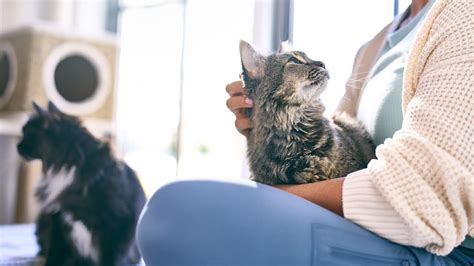Introduction
Multi-cat households are becoming increasingly common, as more and more people are choosing to share their homes with multiple feline companions. While having multiple cats can be a rewarding experience, it can also come with some challenges, such as aggression, territorial disputes, and litter box problems. Cat training can be an effective way to address these issues and create a more harmonious multi-cat household.

Benefits of Cat Training
There are many benefits to training your cats, including:
- Reduced aggression: Training can help to reduce aggression between cats by teaching them how to interact with each other in a positive way.
- Improved territoriality: Training can help to reduce territorial disputes by teaching cats that they do not need to defend their territory from their housemates.
- Better litter box habits: Training can help to improve litter box habits by teaching cats where to go to the bathroom and how to use the litter box properly.
- Increased bonding: Training can help to increase the bond between you and your cats by giving you a way to interact with them in a positive way.
How to Train Your Cats
There are a few different ways to train your cats. You can hire a professional trainer, use online resources, or do it yourself. If you decide to train your cats yourself, there are a few things you should keep in mind:
- Start early: The sooner you start training your cats, the better. Kittens are more receptive to training than older cats.
- Be consistent: Training should be consistent in order to be effective. Practice with your cats every day, even if it is just for a few minutes.
- Use positive reinforcement: Cats are more likely to learn when they are rewarded for good behavior. Use treats, praise, or petting to reward your cats when they follow your commands.
- Avoid punishment: Punishment is not an effective way to train cats. It can make them afraid of you and less likely to cooperate.
Tips for Training Multiple Cats
Training multiple cats can be a challenge, but it is possible with patience and consistency. Here are a few tips:
- Train each cat individually: It is easier to train cats one-on-one. Once each cat has mastered the basics, you can start training them together.
- Use different cues: Use different cues for each cat to avoid confusion. For example, you could use a clicker for one cat and a verbal command for another.
- Be patient: Training multiple cats takes time and patience. Don’t get discouraged if your cats don’t learn as quickly as you would like. Just keep practicing and eventually they will get the hang of it.
Conclusion
Cat training can be an effective way to create a more harmonious multi-cat household. By following the tips in this guide, you can train your cats to behave well and get along with each other.
Appendix
Table 1: Benefits of Cat Training
| Benefit | Description |
|---|---|
| Reduced aggression | Training can help to reduce aggression between cats by teaching them how to interact with each other in a positive way. |
| Improved territoriality | Training can help to reduce territorial disputes by teaching cats that they do not need to defend their territory from their housemates. |
| Better litter box habits | Training can help to improve litter box habits by teaching cats where to go to the bathroom and how to use the litter box properly. |
| Increased bonding | Training can help to increase the bond between you and your cats by giving you a way to interact with them in a positive way. |
Table 2: Tips for Training Multiple Cats
| Tip | Description |
|---|---|
| Train each cat individually | It is easier to train cats one-on-one. Once each cat has mastered the basics, you can start training them together. |
| Use different cues | Use different cues for each cat to avoid confusion. For example, you could use a clicker for one cat and a verbal command for another. |
| Be patient | Training multiple cats takes time and patience. Don’t get discouraged if your cats don’t learn as quickly as you would like. Just keep practicing and eventually they will get the hang of it. |
Table 3: Common Cat Training Problems
| Problem | Cause | Solution |
|---|---|---|
| Aggression | Fear, anxiety, or territoriality | Identify the cause of the aggression and work to resolve it. Consult with a veterinarian or behaviorist if necessary. |
| Territoriality | Feeling threatened or insecure | Provide plenty of resources, such as food, water, litter boxes, and hiding places, to reduce competition between cats. |
| Litter box problems | Medical or behavioral issues | Rule out medical problems with a veterinarian. If there are no medical issues, try to identify the cause of the litter box problems and work to resolve it. |
Table 4: Future Trends in Cat Training
| Trend | Description | Benefits |
|---|---|---|
| Clicker training | Using a clicker to mark desired behaviors | Clicker training is a positive reinforcement method that can be used to teach cats a variety of behaviors. It is a gentle and effective method that can be used with cats of all ages. |
| Target training | Using a target to direct the cat’s behavior | Target training is a great way to teach cats to follow your commands. It can be used to teach a variety of behaviors, such as sitting, staying, and coming when called. |
| Leash training | Teaching a cat to walk on a leash | Leash training can be a great way to give your cat some outdoor time. It can also be helpful for traveling with your cat. |





















